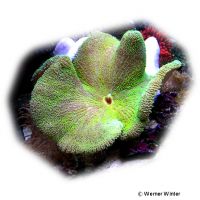Haddon's Carpet Anemone Neon Green (Stichodactyla haddoni 'Neon Green')
| Haddon's Carpet Anemone Neon Green Stichodactyla haddoni 'Neon Green' | |
|---|---|
| Name | Haddon's Carpet Anemone Neon Green |
| Name Lat. | Stichodactyla haddoni 'Neon Green' |
| Family | Host Anemones |
| Family lat. | Stichodactylidae |
| Order | Sea Anemones |
| Order lat. | Actiniaria |
| Origin | Indo-Pacific |
| Diet | Autotrophic, carnivore |
| pH | 8.1-8.4 |
| Hardness | 8-12 °KH |
| Lighting | High |
| Current | Moderate |
| Behavior | Aggressive |
| Keeping | Individual |
| Care Level | Experts only |
| Life Span | N/A |
| Protection | No |
| Metric Units | |
| Size | < 70 cm |
| Temperature | 22-27 °C |
| Salinity | 33-36 ‰ |
| Aquarium | 400 l |
| US Units | |
| Size | < 28" |
| Temperature | 72-81 °F |
| Salinity | 1.020-1.025 sg |
| Aquarium | 100 gal |
Distribution and habitat
Stichodactyla haddoni "Neon Green" are widely distributed from the Red Sea through the Indian Ocean to Fiji in the Pacific. They live solitary in shallow water on sandy soft bottoms, often among seagrass, the foot disc buried and attached to a rock, in symbiosis with anemonefishes.
Maintenance
They should be positioned in a very bright spot on the bottom with moderately strong, alternating currents by pressing them gently on a rock in a pit for a short time.
Only substrates rich in lime and free of heavy metals should be used as substrate. Filters, skimmers and heaters are necessary to ensure water quality, as well as pumps to simulate tides, swells and bottom currents. It is recommended that live stones be used to set up the aquarium. The bacteria living in the porous stones act as a biological filter. The lighting must correspond to the species-appropriate day-night rhythm of the animals
| Salinity: 33-36 ‰ | pH value: 8.1-8.4 |
| Carbonate hardness: 8-12 °KH | Nitrate content: 2-8 mg/l |
| calcium content: 420-450 mg/l | Nitrite content: 0.0-0.05 mg/l |
| Magnesium content: 1.250-1.350 mg/l | phosphate content: 0.01-0.1 mg/l |
Regular addition of trace elements, especially iodine and strontium, is recommended. For salinity, an average value should be aimed for, which may only vary slightly by +/- 0.5 ‰. Ammonia and ammonium must not be measurable. Special attention shall be paid to consistently good water quality and water values.
Diet
Zooxanthellae, which are unicellular symbiotic algae, live in their tissue and provide them with assimilation products of their photosynthesis (high light requirement). The zooxanthellae promote growth and provide additional food to the plankton and small particles collected from the water current. In addition to the food produced in the aquarium when feeding fish, they must be fed specifically at least once a week with small pieces of crustacean, fish or shellfish meat, shrimp, krill, etc. Regular and varied feeding promotes health and avoids deficiency symptoms.
Behaviour and compatibility
These solitary symbiotic anemones should be socialized with anemonefish. In nature they are inhabited by Amphiprion clarkii, A. sebae, A. akindynos, A. chrysogaster, A. chrysopterus and A. polymnus, but Amphiprion ocellaris, A. percula and A. allardi are also accepted. Other animals that stick to their tentacles are devoured. A sufficient distance to corals must be kept to avoid nettling.
Reproduction and breeding
They are separately sexual. Their larvae are part of the plankton for several weeks until they settle in a suitable place. Reproduction by division is also possible, which occasionally succeeds in the aquarium.
Important
Their different coloration, from blue to green, depends on the symbiotic algae in their tissue
After being placed in the aquarium, they sometimes wander until they find a suitable place themselves. Thereby they can endanger other anemones or corals with their nettles.
The anemone fishes living in symbiosis with it are very helpful during the often difficult acclimation. Healthy animals have a closed mouth disc, look "pumped up" and do not drift around. Supplemental Actinic-Light (short wavelength violet-blue light) illumination is very beneficial to their growth (zooxanthellae). With their highly nettling and adhesive tentacles, skin contact is better avoided
Newly introduced animals must be acclimated slowly to the water in the aquarium. If different species are kept together, make sure that fish and invertebrates match each other in terms of water quality and temperature requirements as well as their social behavior, and that the setup meets the ecological needs of all species kept together. Further literature can be found in your pet store.
References
Text: petdata; Image: Werner Winter
Source: BAENSCH & DEBELIUS (2006): Meerwasser Atlas Bd. 1, Mergus Verlag; ENGELMANN & LANGE (2011): Zootierhaltung - Tiere in menschlicher Obhut: Wirbellose, Verlag Harri Deutsch
